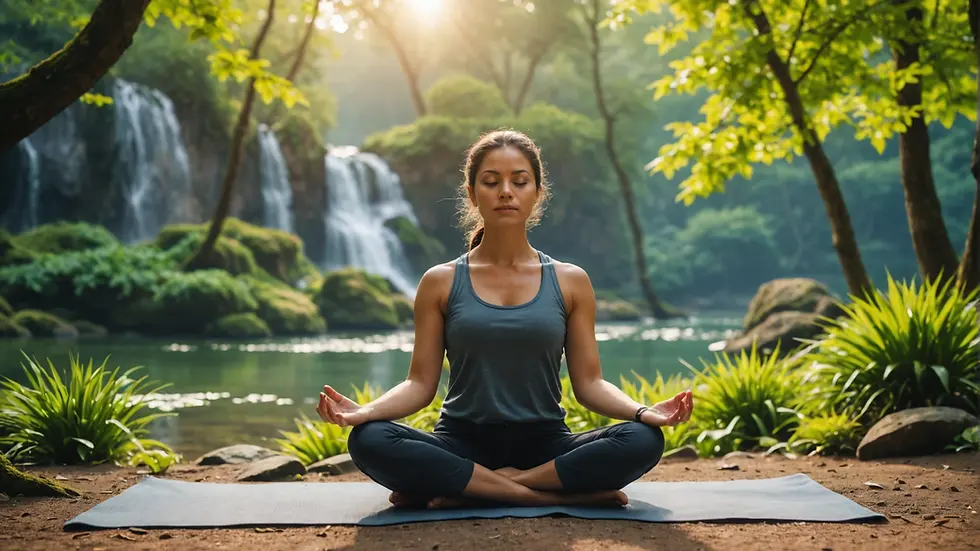HOW TO Practice Mindfulness Meditation: A Beginner's Guide to Cultivating Presence and Inner Peace
- Ella Holland
- Nov 16, 2024
- 3 min read
Updated: Nov 24, 2024
Mindfulness meditation has emerged as a vital practice for those seeking calm and clarity in our fast-paced world. Millions of people worldwide have turned to this technique, finding solace from stress and overwhelm. This guide aims to introduce you to the basics of mindfulness meditation, providing clear, practical tips to help you start your journey toward greater well-being and inner peace.
Understanding Mindfulness Meditation
Mindfulness meditation focuses on being fully present in the moment without judgment. It allows you to observe your thoughts, feelings, and sensations as they arise and pass away. Engaging in this practice helps you understand yourself and the world better.
Studies show that regularly practicing mindfulness can lead to impressive benefits. For example, research conducted by Harvard University found that mindfulness can reduce the brain's worry centers by 27%. Additionally, mindfulness meditation has been linked to a 58% decrease in anxiety levels.

Getting Started with Mindfulness Meditation
Starting mindfulness meditation requires no fancy equipment or extensive training, making it easy for everyone to participate. Here are some foundational steps to guide your practice:
Create a Comfortable Space
Look for a quiet spot where you can sit undisturbed. This can be your bedroom, a cozy corner in your living room, or even a garden. The key is to ensure the area feels safe and inviting.
You might want to include items like cushions for extra comfort or decorations like plants that inspire calmness. The goal is to create an environment that encourages relaxation and focus.
Set an Intention
Before diving into your meditation, think about what you want to achieve during the session. This might be cultivating peace, increasing awareness, or practicing acceptance. A clear intention can greatly enhance your motivation.
Writing down your intention can strengthen your commitment. For instance, if your goal is to reduce stress, jot down phrases like "I seek calm" or "I welcome peace." Revisit these reminders throughout your mindfulness journey.
Choose a Comfortable Position
You can meditate in various positions—sitting, lying down, or walking. However, it's crucial to find one that feels comfortable for you. If you choose to sit, keep your back straight and your posture upright for alertness.
Your hands can rest on your knees or in your lap. If you decide to lie down, be mindful not to doze off; staying alert yet relaxed is essential.

The Practice: Mindfulness Meditation Techniques
Focus on Your Breath
A powerful way to center your mind during meditation is by paying attention to your breath. Start with a few deep breaths to ground yourself, then settle into your natural breathing pattern.
Notice the rise and fall of your chest or the feeling of air entering and leaving your nostrils. If your mind wanders, gently guide your focus back to your breath. This simple act of returning to your breath is fundamental to mindfulness meditation.
Observe Your Thoughts
As you meditate, you may find thoughts popping into your mind. Instead of resisting or getting caught up in them, try to observe them objectively. Imagine your thoughts as clouds floating by—acknowledge their presence without becoming attached.
This practice nurtures a sense of detachment and helps you develop a non-reactive mindset, allowing you to handle stress more effectively.
Embrace Distractions with Kindness
Distractions are part of the meditation process, whether it's physical discomfort or racing thoughts. Acknowledge these occurrences without frustration. Instead of fighting against them, gently bring your attention back to your breath or the present.
Over time, you will learn to see distractions as chances to build your awareness and patience.
Building Your Practice
Start Small and Gradually Increase Time
If you are new to meditation, it's good to start with shorter sessions of about 5 to 10 minutes. As you become more comfortable, consider lengthening your practice to 15, 20, or even 30 minutes.
Focus on consistency over duration; establishing a routine can significantly enhance your mindfulness practice. Research suggests that even short daily sessions can lead to remarkable changes in mood and perspective.
Explore Guided Meditation
If meditating alone feels daunting, consider using guided meditations. Many apps, websites, and podcasts offer structured sessions designed for beginners.
These resources can make it easier to engage with meditation and keep you motivated by providing clear directions and insights into mindfulness practices.
Embracing Your Mindfulness Journey
Mindfulness meditation offers a path to better well-being and inner calm. By incorporating the steps in this guide into your daily life, you can start reaping numerous benefits.
Remember, every individual’s mindfulness journey is unique. Approach your practice with patience and compassion, allowing it to unfold naturally. Over time, you may discover a powerful sense of awareness that enhances every aspect of your life.

In your quest for mindfulness meditation, you may find the beauty in each moment and the inner peace that resides within you. Embrace the journey, and allow your practice to guide you toward a place of balance and serenity.






Comments